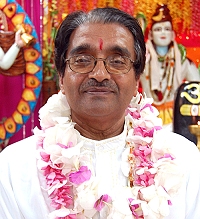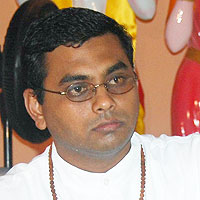Paramacharya of SWAHA, Pundit Hardeo Persad
In the teachings of Sanaatan Dharma, when Paramshiva, the Supreme Soul creates, he is known as Brahma. When he sustains all that was created, He is known as Vishnu Bhagavan and when He destroys and re-absorbs everything back into Himself, he is known as Shiva Bhagavan. In Taittiriya Upanishad it is stated: “Whence all elements came forth, by which once born they exist, into which they enter and dissolve.” This, in brief, is what Shivaji represents, i.e., the total disintegration and absolute dissolution of all existence into the Infinite or Supreme Soul.
Co-existing with the Infinite Brahman is His dynamic or kinetic energy, Parashakti, through whose expression the five-fold duties of srishti (creation), paalan (sustenance) , sanhaar (destruction), teerobhaav (removal and concealment) and anugraha (showering of favour and grace) are carried out. When identified with shakti (primeval energy), Paramshiva, the absolute impersonal God or nirgun Brahman (God without form), becomes sagun Brahman or God with form. Brahma, Vishnu and Shiva Bhagavan are all one Brahman, but they are differentiated states, conditioned, so to speak, with attributes.
Shiva Bhagavan, in this finite form, possesses attributes that clearly distinguish Him as the Lord of all creation, the unchangeable One, the One who is the known, the unknown and beyond the unknown as well. The universe and everything in it are in Him, yet He is beyond all things. He is Brahman, out of which all things emanate and into which all things merge. He is the basis of all creation. He signifies tamas prakriti, the state of inertia, non-differentiated, motionless and homogeneous, as symbolised by His white colour.
To His devotee Shivaji is Dayaakar – the Lord of compassion who protects one from negative influences. Also known as Vardaataa, the Lord who grants boons to anyone who sincerely seeks Him. As Yogeshwar, He reminds one to strive towards attaining the state of vairaagya or dispassion, in order to be able to rise above the world of materialism. Peace of mind can only ensue from vairaagya which is symbolised by His matted locks.
By performing saadhan or spiritual sacrifices, one is able to break through the barriers of illusion, to transcend materialism and to identify with Divine attributes. Only then can one move closer to experience the non-duality extolled in the maxim: Chidaananda Roopaha Shivoham, Shivoham, “I am the form of consciousness and bliss. I am Shiva, I am Shiva.” To the aspirant, the sole focus is recognising that the soul is beyond all dualities and that the journey of one’s entire existence is to realise oneness with the Divine.



